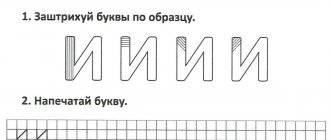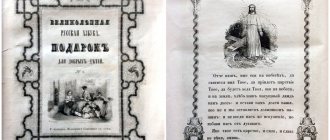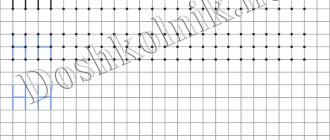Abstract: The article is addressed to speech therapists in preschool institutions. It presents many years of experience in automating sounds at the initial stages of learning using sound symbols according to the method of M.F. Fomicheva. Colleagues are encouraged to adopt one of the methods of working with children whose sound pronunciation is impaired. This technique is suitable for automating any delivered sound.
Here's the sound. And very often, further work on automation comes down to only repeating syllables and words after the speech therapist, which leads to a boring lesson. Therefore, the proposed option for automating sound with drawing and simultaneously pronouncing a word will interest the child and diversify the learning process.
It is better if this work is carried out in a preschooler’s workbook, since parents will be able to repeat and consolidate the material worked out with a speech therapist in the future at home.
Let's consider this technique using the example of the sound L.
So, the sound is on. How to introduce it into speech?
Stage I. Automation of sound in forward and backward syllables
The child is introduced to the sound symbols of M.F. Fomicheva.
The plane is humming L-L-L Anya is crying A-A-A Olya is groaning O-O-O The train is humming O-O-O The bear is growling Y-Y-Y
Next, they suggest placing pictures-symbols in the windows.
Moving the pictures along the path lines, the child simultaneously pronounces straight syllables.
For example:
“The plane is flying to Anya L-L-L-LA” “The plane is flying to Olya L-L-L-LO” “The plane is flying to the train L-L-L- LU” “The plane is flying to the little bear L-L-L- LY" Then they practice the reverse syllables: "Anya is going to the plane A-A-A-AL" "Olya is going to the plane O-O-O-OL" "The train is going to the plane U-U-U-UL" "The bear is going to airplane Y-Y-Y-YL"
Cheat sheet with phonetic transcription symbols
return to the page “Phonetics in tables” “Tables“, “Phonetic analysis”
Cheat sheet with phonetic transcription symbols
j → [jievó] him, [cjе]st will eat, a[d'ju]tant adjutant, [vjý]ga blizzard, bu[l'jó]n broth sh' → [sh'ːrok'j] cheeks, [jеш 'ːó] still, [bowl'ːʌ] thicket, [pr'iesh'ːur] squint, [sh'ːukʌ] pike ^ → [bʌl'ez'n'] disease, [mΛjá] my, [grmʌt'ichsk'j ] grammatical ъ → [пърʌhot] steamship, [gorʹt] city, [vdʌvós] water carrier, [zádal] asked ie → [jievó] him, [jiesh'ːro] still, [ed'ot] is coming, [n'iecto] nobody , [n'iesla] carried ь → [м'рʌво́j] world, [zam'jr] froze, [jesl'ь] if, [v'ek'ь] eyelids ye → [trʌnskr'iptsyejъ] transcription, [zhyel' et'] to feel sorry for, [lyshyed'ej] horses - the sound j is used to denote the iotated vowels e, e, yu, i [in j
ý]ga blizzard and designations y [ma
j
kʌ] T-shirt -sound [sh′] sch (indicated in writing by the letter
ь); a doubled (long) sound is indicated by an overbar or a colon [w′:iká] cheek, [bowl′:a] thicket-sound j is used to denote iotated vowels e, e, yu, ya [вjý]ga blizzard and designation й [majkʌ ] -in the second, third pre-stressed syllables, in post-stressed syllables, vowels [a], [o], [e] sound after hard consonants: roof a [krysh ъ ], tse likom [ts b l' ikom] ryb a [ryb ъ ] - in the pre-stressed syllable after soft consonants, in place of the vowels [a], [o], [e], a sound close to [i] . In the school version of the transcription it is usually denoted as [i] , although this sound sounds more like [i] with the overtone [e] - [ie] . -in the second, third pre-stressed syllables, in post-stressed syllables, vowels [a], [o], [e] sound after soft consonants: ry dovoy [р'ь davój ], pol e [pol' ь ], watchmaker [ h' sΛfsh'ik ] - after hard [zh], [sh], [ts] before a soft consonant in place of [a] there is usually a sound intermediate between [s] and [e] (indicated [ые] )
TRANSCRIPTION SIGNS
[ ] Transcription boundaries (emphasizing a sound, word or part thereof)
['] Soft consonant sign
[—] or [:] Sign of longitude of sound
ie Sound intermediate between i and e
Ъ, ь Reduced vowels (o, a, e) in all unstressed syllables, except the first prestressed one
^ Reduced vowel (o, a) in the first pre-stressed syllable and the absolute beginning of a word: [^na], [v^da]
The sign [ъ] (“er”) conveys a very short sound, its quality intermediate between [ы] and [а]. The vowel [ъ] is one of the most frequent sounds in Russian speech. It is pronounced, for example, in the 2nd pre-stressed syllables and in post-stressed syllables after hard syllables: p[a]rohod steamer, v[a]doz water carrier, zad[a]l set, gór[a]d city.
In similar positions, after soft consonants, a sound is recorded that is reminiscent of [and], but shorter. This vowel is conveyed by the sign [ь] (“er”): [m’j]rovoy world, [m’j]lovoy chalk, zá[m’j]r froze, zá[l’j]zhi deposits.
If you have any questions, ask in the discussions https://vk.com/board41801109 If you have mastered the topic, share with your friends. Test on the topic Transcription #discussions_Russian_language_without_problems
return to the page “Phonetics in tables” “Tables“, “Phonetic analysis“
Stage II: Automation of sound in words
Let's consider this stage of work using the example of the sound of L. The speech therapist draws a picture and asks the child questions. It is possible for the child to draw or color the picture himself.
Sample questions: “What do I draw?”, “What do I paint over?”, “What happened?”, “What word will I write under the picture?” etc.
Thus, the child pronounces one word several times, and the sound in the word is automated.
On a page in a child’s notebook there are 6 pictures in this way:
If a speech therapist or parent does not have artistic skills (and they are not the main ones here), then you can replace the drawings with ready-made pictures.
In this way, picture words are typed until the specialist is sure that the sound is introduced into speech at the word level. As a rule, words are first selected with a sound at the beginning of the word (lamp, magnifying glass, boat, skis...), then in the middle of the word with straight syllables (pigeons, baby, saw...) and in the middle of the word with a combination of consonants (shawl, ball, flag... ), only then with a practiced sound at the end of the word (table, woodpecker, football...).
Special symbols in preparing 4-year-old children for learning to read and write, Tkachenko T.A., 2000
Special symbols in preparing 4-year-old children for learning to read and write, T.A. Tkachenko, 2000. The manual by the famous Moscow speech therapist-practitioner, author of 10 books, presents theoretical principles and practical recommendations, as well as a system of training for 4-year-old children their skills of sound analysis and synthesis, without which mastering literacy is impossible. The use of original author's symbols makes it possible to most effectively prepare children with and without problems in speech development to master reading and writing. The manual contains entertaining games and exercises, as well as lesson notes that are recommended to be carried out with preschoolers in children's educational institutions and with their families. Addressed to teachers of mass and correctional groups, defectologists and speech therapists, students of pedagogical universities and colleges, as well as tutors and parents of preschool children. Introduction. The main task of any preschool institution is to prepare the child for school, including the acquisition of written language. One of the indicators of a child’s readiness to read and write is clean, clear, correct speech in all respects. At the age of 4, many children correctly pronounce all the sounds of their native language without the intervention of a speech therapist, and it would seem that there are no obstacles to their acquisition of literacy. At the same time, in the process of teaching such preschoolers to read and write, adults may encounter certain difficulties. Using this manual will help you overcome them, turn learning sound analysis into an interesting and at the same time effective game, and answer many theoretical and practical questions for teachers and parents. If a 4-year-old child has pronunciation defects or more complex speech disorders (dysarthria, rhinolalia, alalia, general speech underdevelopment), then the process of teaching literacy to such a preschooler is seriously complicated. Content. Introduction. Information that is useful to know for teachers and parents who are preparing to teach a preschooler to read and write. The role of symbols in preparing preschoolers for literacy. Planning and conducting classes to prepare for learning to read and write in mass groups of children's educational institutions. Conducting classes on the formation of the phonetic side of speech in speech therapy groups. Lesson notes. Bibliography. Application. Visual material (images of special characters).
Download the e-book for free in a convenient format, watch and read: - fileskachat.com, fast and free download.
Below you can buy this book at the best price with a discount with delivery throughout Russia. Buy this book
How to open a file
Copyright holders
- pdf - Yandex.Disk. - djvu - Yandex.Disk.
Publication date: 07/02/2019 09:07 UTC
Tkachenko :: 2000 :: child :: preparation :: literacy
See also textbooks, books and educational materials:
- Teaching literacy in kindergarten, Starzhinskaya N.S., 2000
- Preparation for teaching literacy to children 5-6 years old, scenarios of educational activities, Zhurova L.E., 2013
- Syllable structure of a word, Correction of violations, Speech therapy notebook, Tkachenko TA
- Education with sound, music lessons, Rokityanskaya T.A., 2005
The following textbooks and books:
- Preparing children for school, a manual for parents, Bolsun N.V., Revtovich N.M., 2007
- Educational moments, how to love a child, leave me to the children, Korczak Y., Stotskoy L., 2017
- Classes with children 2-3 years old, social development, the world around us, Vinnikova G.I.
- Preparing disabled children for family and adult life, a manual for parents and specialists, Yarskaya-Smirnova E.R., 2007
Previous articles:
- The main book about education, how great it is to be with children, Surkova L., 2018
- Children from heaven, parenting lessons, how to develop a spirit of cooperation, responsiveness and self-confidence in a child, Gray D., 2013
- Implementation of a systematic approach in youth education, monograph, Ananyin G.E., Bayborodova L.V., 2012
- Staging sounds.
<< Previous articleNext article >>
Speech therapy manual for children
Developing a sound culture is a complex matter. Children quickly get used to speaking incorrectly and are difficult to retrain. Many books are published for the educational process.
The speech therapy manual for children, edited by Bogomolova, contains all the necessary material for automating all speech sounds. Methods of production and important aspects of the work are briefly described. Such information will be useful not only to speech therapists, but also to parents.
A child needs to be taught to speak correctly from childhood. Otherwise, he will have difficulties with writing, reading and counting. Improper pronunciation can cause complexes.
Sound culture is the key to confidence in adulthood. Therefore, she needs to pay a lot of attention.
Hard and soft consonants
How to teach a child to distinguish soft sounds from hard ones? We must start with the fact that softness and hardness are characteristics only for consonant sounds. The vowels here are in the chorus. Although hardness and softness are not typical for them, it is their close proximity in some words that can affect these properties of consonant sounds. The main difference between soft and hard sounds is the peculiarities of their pronunciation.
If a person pronounces soft consonant sounds, then the middle of his tongue rises to the palate and blocks the passage through which the air moves, and the tip moves slightly forward towards the teeth. This is additional articulation. The process itself is called palatalization.
Kids don’t need to know such complexities, but parents may find this term useful to broaden their horizons. This does not happen when pronouncing solid sounds.
To understand the difference yourself, it is enough to say a test word in which the same sound acts as a hard and soft sound.
Let's take "break" as an example. Pronunciation of the first consonant sound [p'] makes the tongue dance in the mouth and rise to the sky, but for the second consonant sound [p] these somersaults are not needed.
It’s easy for parents to understand the difference, but how can you explain it to a child? We suggest using your imagination and using interesting stories, cheat sheets and simple games that will help kids remember hard and soft consonant sounds.





